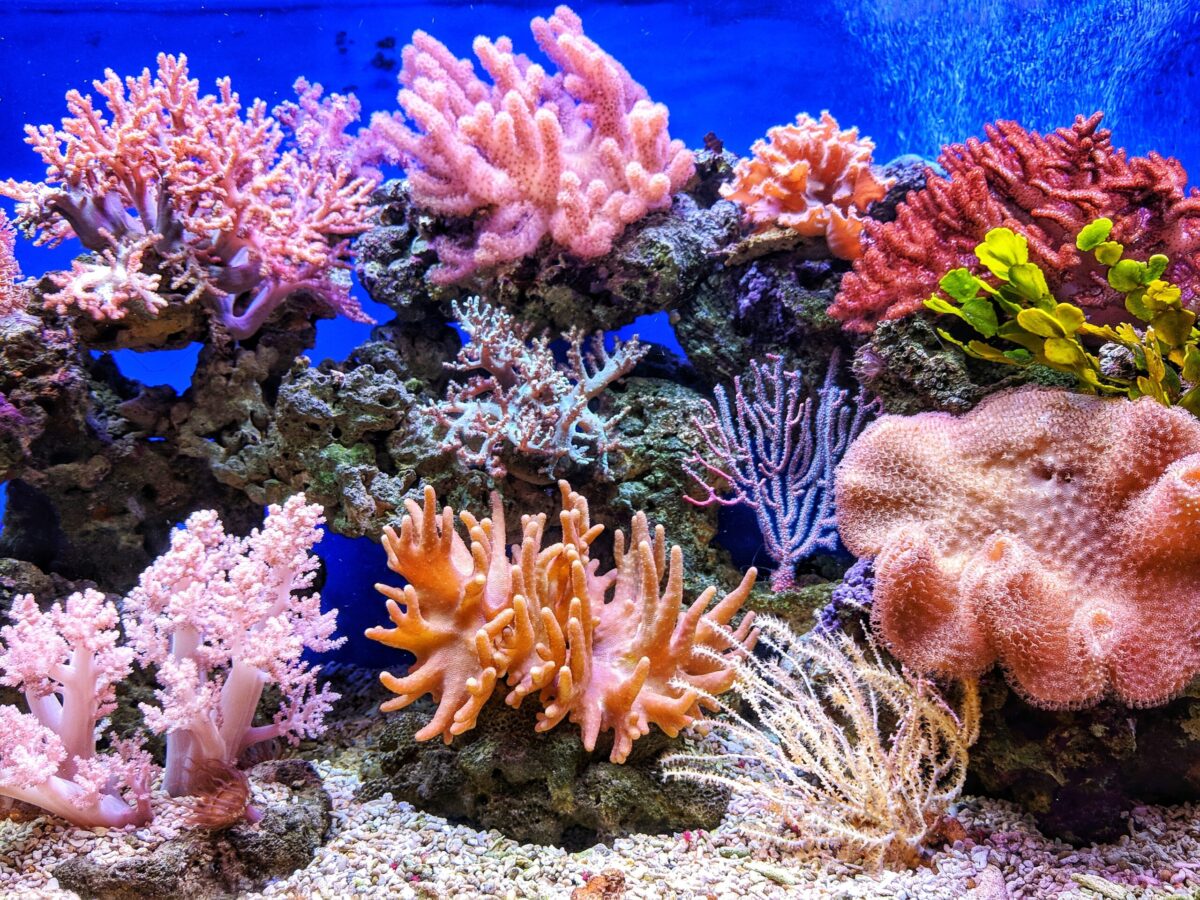DISCOVERING THE BIODIVERSITY OF THE MAYAN RIVIERA
PART 2: The Mayan Underworld
Welcome back, Foodies, I’m glad that your hunger for Mayan cultural knowledge brought you to the second part of our Ultimate Guide of Animals You Can Find in The Riviera Maya. In this post, we will brag a little about the beauty and diversity of the Mayan Ecosystems that attract millions of adventurous tourists and species from all around the world.
So put on your bathing suit and join us on an adventure under the Mayan Waters, which are more than one ecosystem!
THE MANGROVES
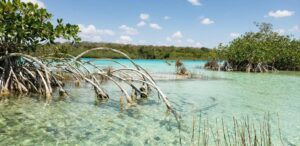
source: Lucesdelsiglo.com
Mangroves are ecosystems of great ecological importance that provide a wide variety of environmental services. These are groups of trees made up of 4 varieties of mangroves up to 10 meters tall, capable of living in brackish waters, a combination of fresh and salt water, and excellent soil protectors as they filter the water and protect the coasts against hurricanes and storms.
Located between land and sea, the mangrove roots provide suitable habitats for many wildlife species like monkeys, frogs, iguanas, migratory birds, oysters, sea urchins, and shrimp as well as a large number of fish such as catfish, mojarras, snappers, and tarpons, which uses the coastal wetlands as important breeding areas and refuges before migrating to the open sea and coral reefs.
But let me introduce you to a couple of particularly interesting water dwellers of this tropical Waterworld:
The Crocodile, King of the Mangroves
Mayan Name: Itzam can ain
Scientific name: Crocodylus Acutus.
Hiding all over the mangroves we can find the River Crocodile (a.k.a American crocodile), a large reptile that is distinguished by its large size ranging from 4m long reaching up to 6m. Scales are a light gray color and have dark spots with no marks on the belly. It has a muscular and thick tail, while its legs are usually short.
The eyelids of the American crocodile open and close laterally and are provided with glands that secrete excess salt through the eyes in the form of the famous “crocodile tears”, which is why they can live in both fresh and brackish waters and even enter the sea to colonize new territories.
Young crocodiles feed heavily on fish and insects until they become larger and capable of taking down larger prey such as small mammals, birds, and even other reptiles. Crocodiles have been known to be cannibalistic, this includes eating their newborn species.
The crocodile was the first of the signs of the ritual calendar of the Nahuas, related to water and fertility, in other ancient myths, the crocodile body was considered as the Earth and its jaws as the entrance to the underworld. Among the Mayans, it was related to one of the most important gods: Chaak, the god of rain.
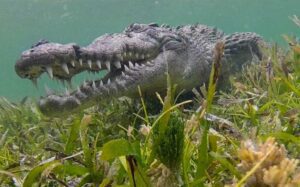
source: Mexicodesconocido.com.mx
Chesapeake Blue Crab.
Mayan Name: Bab
Scientific name: Callinectes sapidus.
Some say that the true kings of the mangrove are the mollusks although the crabs still fight for the dominance of the mangrove. These gray and blue fellas climb on the roots and feed on fruits, leaves of different trees, coconuts, and even small oysters stuck in the roots of the mangroves.
During the day you can find them while hiding buried in the sand, but they often live among mangrove swamps or coconut trees.
The reproductive circle of the Blue Crab is linked to the water and the lunar phases, on rainy September days the crabs begin their migration to the sea and during this walk, most females, who are recognized by the reddish sparkles on the tips of their claws are usually seen carrying their eggs on a dangerous journey to the ocean to lay their eggs.
Nowadays, every year, both locals and tourists, participate in campaigns to help the crabs reach the ocean without running the risk not only of being attacked by their natural predators but also being crushed on the noisy route full of cars and buses.
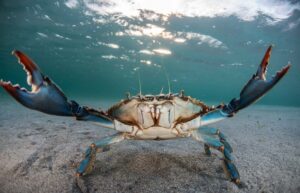
source: canalmarmenor.carm.es
The Manatee, the Mayan Mermaid
Mayan Name: Chiil´bek
Scientific name: Trichechus Manatus
A chubby marine mammal that has had a long evolution for millions of years. In ancient times such sea creatures were believed to be mermaids because people from the old world haven’t seen manatees until they came to Mayan territories.
The manatee is a harmless herbivore that feeds on algae and plants that can also be found on the coasts, rivers, bays, canals, coastal lagoons, and cenotes connected to the sea.
These “Sea Cows” own robust bodies, measuring 3m in length, and can reach up to 3,500 pounds in weight, eventually reach 60 years of age, and have a calf every 3 years. It is characterized by its slow movements and its means of impulse, with the tail and the anterior fins.
Although it is a peaceful animal, the manatee is considered an endangered species due to the abundant traffic of boats in their habitats, the pollution of Mexican coastal waters, and the illegal catch by fishermen. The Manatee Sanctuary, located in Chetumal Bay in Quintana Roo is a hopeful place for the preservation of these marine mammals and for several endangered species that are relevant to the balance of the ecosystems of the region.
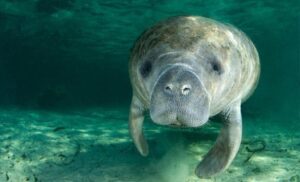
source: mexicodestinos.com
THE GREAT MAYAN REEF & THE MEXICAN CARIBBEAN
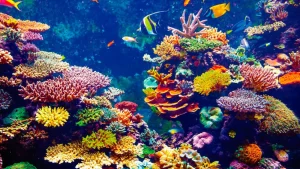
source: gq.com.mx
The main attraction of the Riviera Maya is undoubtedly the blue-turquoise waters decorating the edge of the jungle and protecting The Great Mayan Reef, the largest coral reef in America. The inhabitants of Mexican Caribbean lands share these neighborhoods with thousands of marine species which are an essential part of the ecosystem and also generate great attraction for tourism.
Coral Reefs are beautiful natural structures found in shallow ocean areas that are formed mainly by stonelike coral skeletons made of calcium carbonate. Corals are small marine animals that look like vibrant-color outcrops and are animals most closely related to jellyfish. When individual corals, called polyps grow next to each other, they form large colonies, creating larger reefs. Scientists estimate that 25 percent of all marine species live in and around “the rain forests of the seas”, making them one of the most diverse habitats in the world.
The Great Mayan Reef is home to underwater caves, sunken ships, and cannons with secrets from the past and vibrant multicolored marine life, more than 65 species of corals, 350 species of mollusks, and more than 500 species of fish, including numerous protected or severely endangered species.
Fishing in the Riviera Maya represents the most ancient and economically important activity with a wide variety of important fishing species like lobster, followed by fine-scale species such as grouper, snapper, Mahi Mahi and octopus.
The Mayans asked permission from the owners or lords of seawater, rivers, lakes, lagoons, wells, and cenotes to fish, offering as payment objects appreciated by them or parts of the same catch. However, whoever dared to exploit more than allowed or necessary for their sustenance or work, would be punished, even paying for their mistakes with death.
Did you know that Riviera Maya is a perfect natural habitat for many shark species?
The Mexican Caribbean Sea is one of the largest and most important shark habitats, you can find amazing species, such as the whale shark, the bull shark, the spinner shark, the small tail shark, and the lemon shark.
These two ecosystems hold hundreds or even thousands of species but I’ve picked these three that you MUST look for when visiting these blessed waters:
There’s always a bigger fish… unless you’re The Whale Shark
Mayan Name: K’an xok Masam
Scientific name: Rhincodon typus
Every summer, the warm waters of the Caribbean Sea greet the largest shark species in the world: The whale shark, which usually measures up to 12 meters and weighs up to 15 tons and contrary to what might be believed as a result of popular myths they are the friendliest shark you could ever swim with. The Yucatan Peninsula which is rich in nutrients, algae, krill, and plankton, is the ideal place to feed this monumental size species. One of its main characteristics is its huge mouth, which can measure almost 2m wide, and although on many occasions it is mentioned that it has no teeth, that is totally false since they have several rows that house a large number of small and sharp teeth. Its body is elongated and extremely robust, with a wide, flattened head and a pair of small black eyes. Its belly is completely white with a dark gray back. The enormous amount of moles and white lines originated its local name: Domino, these spots make it an exceptional animal in the animal kingdom.
The Whale Shark Festival in Isla Mujeres is celebrated every year displaying various activities for locals and visitors in order to inform about issues related to this amazing marine species and a responsible coexistence with it.
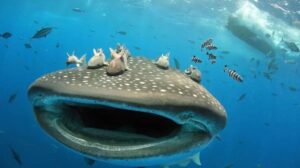
source: republica.com
The Queen Conch
Mayan Name: Tut, un Xul
Scientific Name: Aliger gigas.
One of the largest mollusks living in the Caribbean Sea, reaching up to 35 cm in shell length, is identified by a large whorl-shaped shell with numerous spines at the top and a pink interior. They are herbivores feeding on a variety of algae, growing very slowly taking four to five years to reach sexual maturity and reproduce but living as long as 30 years.
For centuries, it has been one of the most important fishery resources in the Caribbean and has also been used for tools, jewelry, decoration, fishing bait, and as musical instruments since the Mayan times, using it as a trumpet to announce the beginning of a religious ceremony.
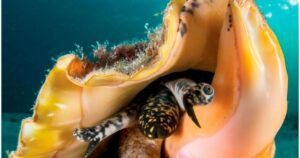
source: sinembargo.mx
The Green Sea Turtle
Mayan Name: Áak
Scientific Name: Chelonia mydas
The beaches of the Mexican Caribbean, in addition to being beautiful, have the privilege of hosting a spectacle in which sea turtles emerge from the oceans during full moon nights to lay their eggs on the white sands. Depending on the species, turtles can spawn 2 to 4 times during the nesting season, so it is important to keep the beaches clean and free of obstacles during the months of May to October, which is the official nesting season for sea turtles. in Quintana Roo.
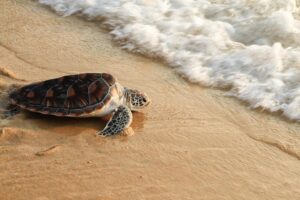
source: expertoanimal.com
CENOTES
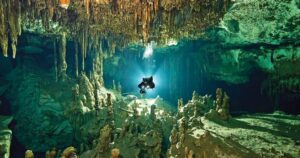
source: scubadiving.com
The Yucatan aquifer ecosystem is marked by three large underground caves considered to be the largest in the world, rivers, caverns, and cenotes. In fact, these are some of the spaces that most attract international tourism, especially cenotes and stalactite and stalagmite caverns.
Cenotes are surrounded by mangroves, palms, and ferns, while others are surrounded by coconut palms, cacao, and chicozapote, the bubblegum resin trees.
The long roots of these trees can be seen below in the cenotes as they go down from the ground until they reach the water.
The flora and fauna of a cenote are as unique as the cenotes themselves since there are unique plants and species in their environment.
Cenote Catfish
Mayan Name: Box cay
Scientific Name: Bagre
Cenote Bagre can be found swimming in Veracruz, Colombia, and the Yucatecan cenotes. It is more active at night and able to disperse between cenotes through caves, which explains its presence also in locations further from the coast. Even some of its subspecies have reduced eyes and pigment, as is usual in cavefish. The cenote bagre is omnivorous in some environments, but in cenotes, it’s a big predator and feeds from other fish, as well as invertebrate species, crustaceans, and insects from the cenotes. It’s not a small fish, as it can reach 30 cm in length and its main breeding season goes from March to July. Despite being so abundant and common, it is listed as an endangered species.
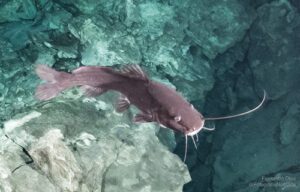
source:inaturalist.org
Yucatecan Blind Swamp Eel
Mayan Name: Can cay
Scientific Name: Ophisternon infernale
The blind swamp eel is an elongated, wormlike fish with no pigment, no scales, and no visible eyes, endangered species endemic to the depth of the cenotes of the Yucatan Peninsula in Mexico. The American ichthyologist Carl Leavitt Hubbs named the fish Pluto infernalis because he liked to associate creatures living underground with the devil, and gave diabolical names to cave fishes. The environments where it lives present its only source of energy, the organic matter that falls into the caves and the guano of bats and swallows.
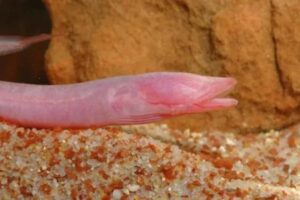
source: Ecologiaverde.com
Mexican blind brotula
Mayan Name: Sak kay
Scientific Name: Typhliasina pearsei
The “White Blind Lady” is a freshwater fish that can only be found in the caverns and cenotes of the states of Quintana Roo and Yucatan, observed for the first time in the caves of Balankanché from where it has disappeared due to the pollution of the cenotes. They look like small fish, with a length of fewer than 10 centimeters and they do not have eyes, the lack of pigmentation is where it gets its name from.
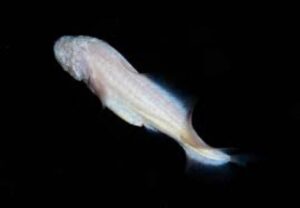
source:naturalist.com
It is worth mentioning that it is our mission to protect each of these ecosystems and their inhabitants. Currently, coral reefs and cenotes are threatened by climate change, nutrient discharge through rivers and coastal areas, fishing, and emerging diseases. In particular, the Mesoamerican Reef System is considered a Critically Endangered ecosystem due to the projection of the negative effects of coral bleaching on live coral cover and fish biomass.
Cenotes and coral reefs are very frail ecosystems and home to a lot of living organisms, if you put sunscreen or any other chemical product (bug repellent, makeup, body lotion, etc), regardless of it being “biodegradable”, before entering the water, you are introducing a foreign chemical agent to the ecosystem, polluting these sacred waters and affecting all the life that depends on them.
Please, keep this in mind the next time you visit the Riviera Maya so you can still be able to enjoy the beauty of connecting with nature.
Keep a weather eye on the horizon for Part 3 of Animals You Can Find in The Mayan Riviera.
And remember, when life gets you down, all you gotta do is: Just Keep Swimming!
– Abbey

